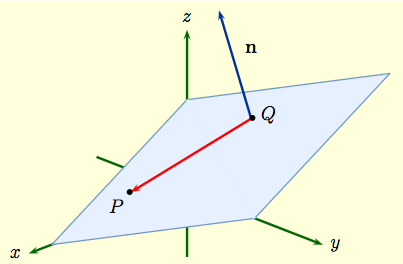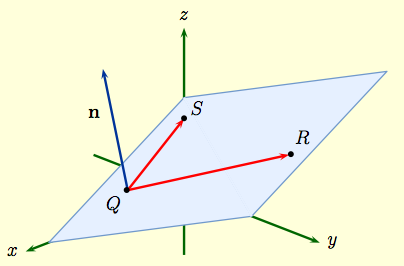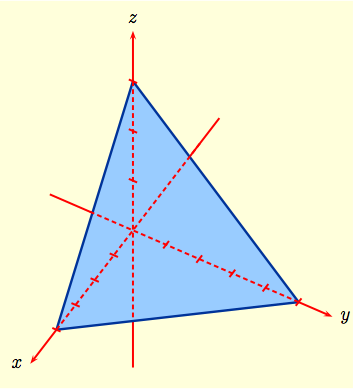Main page
Chapter 10: Parametric Equations and Polar Coordinates
Chapter 12: Vectors and the Geometry of Space
Learning module LM 12.1: 3-dimensional rectangular coordinates:
Learning module LM 12.2: Vectors:
Learning module LM 12.3: Dot products:
Learning module LM 12.4: Cross products:
Learning module LM 12.5: Equations of Lines and Planes:
Equations of a lineEquations of planes
Finding the normal to a plane
Distances to lines and planes
Learning module LM 12.6: Surfaces:
Chapter 13: Vector Functions
Chapter 14: Partial Derivatives
Chapter 15: Multiple Integrals
Equations of planes
Planes: To describe a line, we needed a point ${\bf b}$ and a vector ${\bf v}$ along the line. We could also start with two points ${\bf b}$ and ${\bf a}$ and take ${\bf v} = {\bf a} - {\bf b}$.
To describe a plane, we need a point $Q$ and a vector ${\bf n}$ that is perpendicular to the plane. Later on, we'll see how to get ${\bf n}$ from other kinds of data, like the location of three points in the plane.
|
|
|
| Let $Q(a,\,b,\,c)$ be a fixed point in the plane, $P(x,\,y,\,z)$ an arbitrary point in the plane, and ${\bf n} = \langle\,A,\,B,\,C\, \rangle$ the normal to the plane. If $${\bf b}\,=\, \langle\,a,\,b,\,c\, \rangle\,, \qquad {\bf r} = \langle\,x,\,y,\,z\, \rangle\,,$$ the vector $$\overrightarrow{QP} \ = \ {\bf r} - {\bf b} \ = \ \langle\,x-a,\,y-b,\,z-c\, \rangle $$ lies in the plane, and is perpendicular to ${\bf n}$. | Thus ${\bf n}\cdot ({\bf r} - {\bf b}) = 0$. In terms of coordinates, this becomes $$ \langle\,A,\,B,\,C\, \rangle\cdot \langle\,x-a,\,y-b,\,z-c\, \rangle \ = \ 0\,,$$ where ${\bf n} = \langle\,A,\,B,\,C\, \rangle$. In other words, we get the point-normal equation $$A(x-a) + B(y-b)+C(z-c) \ = \ 0 \, .$$ for a plane. |
To emphasize the normal in describing planes, we often ignore the special fixed point $Q(a,\,b,\,c)$ and simply write $$Ax + By+Cz \ = \ D$$ for the equation of a plane having normal ${\bf n} = \langle\,A,\,B,\,C\, \rangle$. Here $D = {\bf n}\cdot {\bf b} = Aa+Bb+Cc$. The next three examples show useful this way of writing planes can be.
|
Example 1: Find an equation for the plane whose
graph in the first octant is
|
Solution: The basic idea is to look at the
points of intersection of the plane and the coordinate axes: now
$$Ax + By + C z \ = \ D$$
intersects the $x$-axis when $y = z = 0$, i.e., when $x = D/A$. Similarly, it intersects
the $y$-axis when $y = D/B$, and the $z$-axis when $z = D/C$.
Thus from the given graph $$\frac{d}{a} \,=\, 4,\qquad \frac{d}{b} \,=\, 5,\qquad \frac{d}{c} \,=\, 3\,.$$ Consequently, $$\frac{x}{4} + \frac{y}{5} + \frac{z}{3} \ = \ 1$$ is an equation for the plane. |
|
Example 2: Find the vector equation of the line passing through the point $P(2,\,-4,\,3)$ and perpendicular to the plane
$$x+4y - 2z \ = \ 5\,.$$
Solution: when the line is perpendicular to the plane, then the direction vector of the line is parallel to the normal to the plane. When the plane is $$x+4y - 2z \ = \ 5$$ this means the plane has normal |
${\bf n} = \langle\,1,\,4,\,-2\,\rangle$. Thus the line has
$${\bf v} \ = \ \langle\,1,\,4,\,-2\,\rangle $$
as direction vector for.
But $P(2,\,-4,\,3)$ lies on the line, so the vector
$${\bf b} \ = \ \langle\,2,\,-4,\,3\,\rangle$$
determines a point on the line.
Consequently, in vector form the equation of the line is $$ {\bf r}(t) = t{\bf v} + {\bf b} = t\langle\,1,\,4,\,-2\,\rangle + \langle\,2,\,-4,\,3\,\rangle\, .$$ |
|
Example 3: Find an equation for the plane passing through the
point $Q(1,\,1,\,1)$ and parallel to the plane
$$2x+3y +z \ = \ 5\,.$$
Solution: parallel planes have the same normal. So any plane parallel to $2x+3y +z \ = \ 5$ has normal $${\bf n} \ = \ \langle\,2,\,3,\,1\,\rangle\,.$$ On the other hand, since $Q(1,\,1,\,1)$ lies on the parallel plane, the vector $${\bf b} \ = \ \langle\,1,\,1,\,1\,\rangle$$ determines a point on the parallel plane. |
Now let ${\bf r} \ = \ \langle\,x,\,y,\,z\,\rangle$ be an arbitrary point on the parallel plane. Then the vector
$$\overrightarrow{QP}\ = \ {\bf r} - {\bf b} \ = \ \langle\,x-1,\,y-1,\,z-1\,\rangle$$
lies in the plane and so will be perpendicular to ${\bf n}$. In this case,
$$ {\bf n}\cdot ({\bf r} - {\bf b})\ = \ \langle\,2,\,3,\,1\,\rangle \cdot \langle\,x-1,\,y-1,\,z-1\,\rangle$$
$$\qquad = \ 2(x-1)+ 3(y-1)+(z-1)\ = \ 0\,.$$
Consequently, an equation for the plane is $$2x +3y +z \ = \ 6 \, .$$ |


